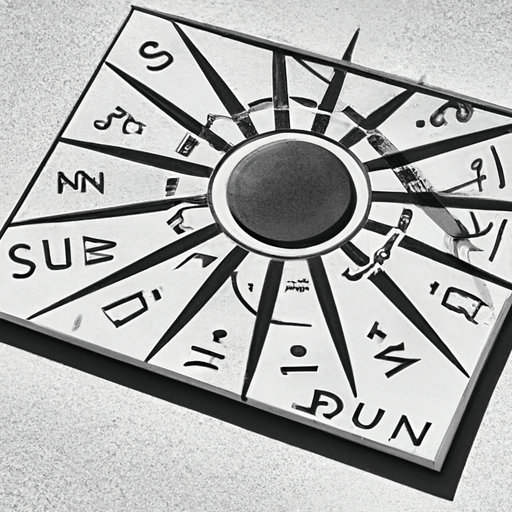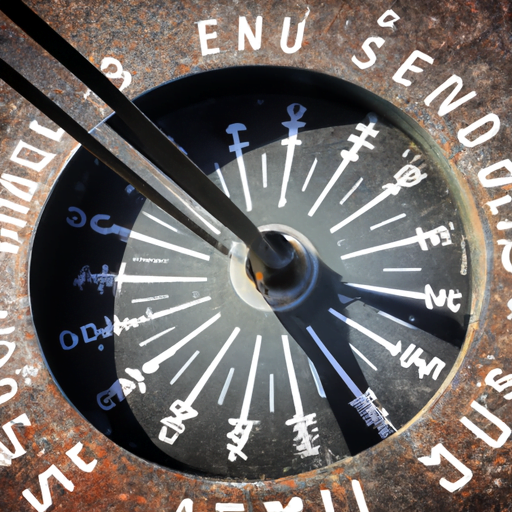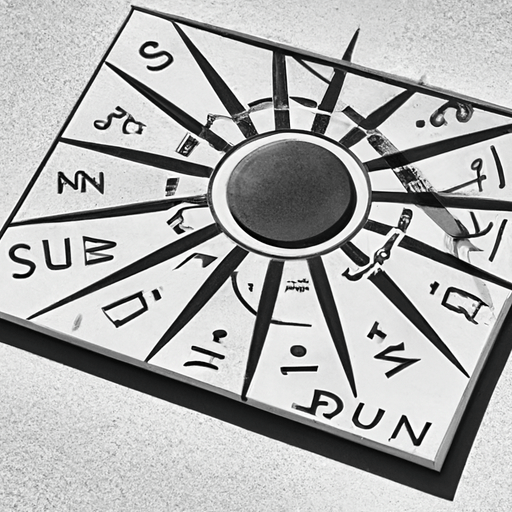Living off the grid is a lifestyle that many aspire to, seeking to disconnect from the hustle and bustle of modern society. But amidst the serene wilderness, away from modern conveniences, a pressing question arises: how do these off-gridders keep time without regular clocks? In a world dictated by seconds, minutes, and hours, their solution might not be as straightforward as you think. From ancient techniques to innovative inventions, join me as I uncover the fascinating ways in which these unconventional individuals navigate their days, all without the constant ticking reminder of time.

Using Sundials
Design and construction of sundials
Sundials have been used for centuries as a method of timekeeping, especially in the absence of regular clocks. The design and construction of sundials vary depending on the location and the purpose they serve. The basic principle behind a sundial is simple – a flat surface, known as the dial, is marked with hour lines and divided into sections that represent the hours of the day. As the sun moves across the sky, the shadow cast by a gnomon (a protruding object) on the dial indicates the time.
The construction of a sundial requires careful consideration of factors such as latitude, longitude, and the angle of the sun at different times of the day. The gnomon should be positioned at an angle parallel to the Earth’s axis to accurately cast a shadow on the dial. Sundials can be made from a variety of materials, including stone, metal, or even wood. The key is to ensure that the gnomon and dial are positioned correctly to maximize the accuracy of timekeeping.
Determining the time using a sundial
Using a sundial to determine the time requires a basic understanding of the dial’s layout and the movement of the shadow created by the gnomon. The hour lines on the dial mark the hours of the day, with the shortest line representing noon and the longest line indicating midnight. The position of the shadow cast by the gnomon on the dial can then be used to estimate the time.
To determine the time using a sundial, one needs to align the gnomon with the North-South direction, either using a compass or by noting the direction of the shadow during noon. Once the gnomon is aligned, the shadow cast by the gnomon will point towards the appropriate hour line on the dial, indicating the current time. However, it’s important to note that sundials are most accurate when the sun is at its highest point in the sky, and they may not provide accurate time readings during cloudy or overcast days.
Observing Natural Cycles
Tracking the position of the sun
For off-gridders, tracking the position of the sun can be a useful way to estimate the time. The sun’s position in the sky changes throughout the day and can be used as a rough guide to determine the time. By observing the height and direction of the sun, one can get a sense of whether it is morning, noon, afternoon, or nearing sunset.
In the morning, the sun rises in the East and gradually moves towards the South as it reaches midday. At noon, the sun is at its highest point in the sky, and its shadows cast on the ground are the shortest. As the day progresses, the sun begins to move towards the West, and shadows lengthen. By paying attention to these natural cues, off-gridders can get a general sense of the time, even without a clock.
Following the moon phases
In addition to tracking the position of the sun, off-gridders can also use the moon’s phases as a way to estimate the time. The moon goes through a regular cycle of phases, from the new moon to the full moon and back again. Each phase corresponds to a specific period of time, allowing off-gridders to gauge the approximate time based on the moon’s appearance.
For example, a full moon appears in the sky at night and is easily recognizable by its bright, full disc. By comparing the moon’s phase to a lunar calendar or their own observations, off-gridders can determine whether it is early evening, midnight, or nearing dawn. While not as precise as a clock, following the moon’s phases can provide a rough estimation of the time, especially in areas without artificial lighting.
Using Hourglasses
History and construction of hourglasses
Hourglasses, also known as sandglasses, were widely used as timekeeping devices before the invention of mechanical clocks. They consist of two glass bulbs connected by a narrow neck, with fine sand or granules inside. The sand takes a predetermined amount of time to flow from one bulb to the other, providing a visual representation of the passing time.
The construction of an hourglass involves precise measurements to ensure an accurate timekeeping mechanism. The size of the bulbs, the diameter of the neck, and the density of the sand all play a role in determining the duration of the hourglass. Traditional hourglasses typically run for one hour, although variations can be found ranging from minutes to several hours.
Measuring time with an hourglass
Using an hourglass to measure time is a relatively straightforward process. The hourglass is turned over, allowing the sand to flow from one bulb to the other. As the sand gradually fills the bottom bulb, one can estimate the elapsed time by observing the level of sand relative to markings on the glass.
Although hourglasses are not as precise as mechanical clocks, they offer a practical and reliable method of timekeeping. They were commonly used on ships and in religious ceremonies, where accuracy was crucial. Today, hourglasses are also appreciated for their aesthetic appeal and the calming visual effect of watching the sand flow.

Using Water Clocks
Evolution of water clocks
Water clocks, also known as clepsydras, have a long history dating back to ancient civilizations such as the Egyptians, Greeks, and Chinese. They operate on the principle that water flows at a constant rate and can be used to measure time.
The early water clocks consisted of a container filled with water that drove a mechanism, such as a float or a pendulum, to mark the passage of time. Over time, water clocks evolved, becoming more sophisticated and accurate. They incorporated features like graduations, which allowed for more precise time measurement.
Mechanism of water clocks
The mechanism of a water clock involves controlling the flow of water from a higher container to a lower one. The water flows through a small aperture, such as a tiny hole or tube, which affects the rate at which the lower container fills. By observing the water level or graduations on the lower container, one can estimate the passing time.
Water clocks require regular monitoring and maintenance to ensure their accuracy. The water level needs to be kept in check, and any blockages or irregularities in the mechanism should be addressed. While water clocks are not as commonly used today, they provide a fascinating glimpse into the ingenuity of early timekeepers.
Utilizing Fire and Burning Timers
Fire as a timekeeping method
Fire has been used as a primitive form of timekeeping for centuries. By observing the burning of candles, torches, or incense sticks, one can estimate the passing time based on the rate at which the fire consumes the fuel. This method relies on the consistent burn rate of the material being used.
When using candles or torches, the length of the wick and the type of wax or fuel can determine how long it will burn. By measuring the initial length or observing the markings on the candle or torch, one can make a rough estimation of the elapsed time based on the remaining length.
Similarly, when using incense sticks, the length of the stick and the average time it takes for each segment to burn can serve as a guide. As each segment burns away, it indicates the passing of a certain amount of time.
Using burning candles or incense sticks
The use of burning timers requires careful observation and familiarization with the burn rate of the chosen material. By noting the initial length or the time required for a segment to burn, one can estimate the remaining time based on the current length. However, variations in burn rate due to factors such as airflow or the quality of the fuel may affect the accuracy of timekeeping.
While using fire as a timekeeping method can be practical in certain situations, it is not as precise as modern clocks. It is more suitable for providing a general sense of the passing time rather than precise time measurement.
Solar and Lunar Tracking
Using solar tracking devices
For off-gridders, solar tracking devices can be a valuable tool for timekeeping. These devices track the movement of the sun throughout the day, providing real-time information on the position of the sun and its angle in the sky. By aligning the device with the sun’s direction, off-gridders can estimate the time based on the position of the sun relative to their location.
Solar tracking devices come in various forms, including simple sundial-like structures equipped with sensors or more sophisticated electronic devices that provide precise data. They typically utilize solar panels or light sensors to detect the sun’s rays and calculate its position. By combining this data with knowledge of the local sunrise and sunset times, off-gridders can determine the time even without a traditional clock.
Moon tracking for timekeeping
The moon’s movement across the sky can also serve as a useful timekeeping tool for off-gridders. By tracking the moon’s phases and its position in the sky, one can estimate the approximate time, especially during nighttime.
If the moon is visible and its phase is known or can be determined, one can use it as a reference point for estimating the time. For example, a waxing crescent moon suggests that it is early in the evening, while a waning gibbous moon indicates midnight or early morning hours. By combining this information with knowledge of the moonrise and moonset times, off-gridders can get a sense of the time even without the aid of regular clocks.
Animal Behavior and Natural Indicators
Observing animal behavior
Nature provides numerous cues that can help off-gridders estimate the time. One such cue is observing the behavior of animals. Many creatures have specific activity patterns that are influenced by the time of day. For example, birds may start singing at dawn, bees may become more active during mid-morning, and nocturnal animals may begin hunting at dusk.
By paying attention to these behavioral patterns, off-gridders can gain insights into the approximate time. Of course, this method requires a certain level of familiarity with the local wildlife and their habits. By observing the natural world around them, off-gridders can enhance their sense of time and align their activities accordingly.
Interpreting natural indicators
In addition to animal behavior, off-gridders can also rely on various natural indicators to estimate the time. For example, the color and quality of the sky at different times of the day can offer clues. The reddish hues during sunrise or sunset, the blue of midday, or the darkening of the sky in the evening can give off-gridders a sense of the approximate time.
Other indicators include the sounds in the environment, such as the call of specific bird species or the chirping of insects, which can change depending on the time of day. The movement and position of shadows, the temperature, and even the smell of the surroundings can all provide subtle hints that aid in time estimation.
While relying solely on natural indicators may not provide precise time measurement, they can act as valuable supplementary tools for off-gridders who embrace a more intuitive and harmonious relationship with nature.
Telling Time by the Stars
Using constellations and star charts
The stars have been used for navigation and timekeeping for thousands of years. By observing the movement and alignment of constellations, off-gridders can estimate the time based on their knowledge of celestial patterns. Constellations are recognizable groups of stars that are relatively fixed in their positions in the night sky.
By familiarizing themselves with key constellations and the general patterns of their movements throughout the year, off-gridders can determine the time by identifying which constellations are visible at a given time. Star charts, which depict the positions of stars and constellations at different times, provide a helpful reference for this method of timekeeping.
Calculating time based on star movements
The movement of stars across the sky is a result of the Earth’s rotation. By observing and measuring the angle between a particular star or constellation and a fixed reference point, off-gridders can estimate the time using basic calculations.
For example, if off-gridders know the location of the North Star (Polaris) and the angle it makes with the horizon, they can determine their approximate longitude and, consequently, the local time. By measuring the angle between the North Star and the horizon using simple tools like a protractor or by using their hand as a measuring tool, off-gridders can make calculations to estimate the time.
Telling time by the stars requires a good understanding of celestial navigation and familiarity with the night sky. However, for off-gridders who spend significant time outdoors and have a keen interest in astronomy, this method provides a meaningful connection to the cosmos while fulfilling the practical purpose of timekeeping.
Using Mechanical Devices
Mechanical contraptions for timekeeping
Mechanical clocks and watches are traditional devices that have stood the test of time. They operate using a complex system of gears, springs, and other components to measure and display the passing time. While these mechanisms require regular winding or power sources, they offer precise and reliable timekeeping.
Mechanical clocks and watches come in various forms, from pocket watches to grandfather clocks, each with its own charm and aesthetic appeal. The craftsmanship and intricate mechanisms involved in these devices make them not only functional timepieces but also works of art.
Traditional clocks and watches
Mechanical clocks and watches have been used by off-gridders for centuries as a reliable means of timekeeping. The precision and accuracy of these devices, combined with their long history and tradition, make them a popular choice for those seeking a more conventional method of time measurement.
However, mechanical clocks and watches do require regular maintenance, such as cleaning, oiling, and occasionally adjusting the timekeeping mechanism. They also depend on a steady power source, whether it be manually winding the mechanism or using a mechanical key or battery.
While mechanical devices offer a practical and accurate means of timekeeping, off-gridders must ensure that they have the necessary resources and knowledge to maintain and care for these intricate timepieces.
Digital Alternatives
Use of solar-powered digital devices
In the modern world, digital devices have become ubiquitous, and off-gridders can take advantage of solar-powered digital devices for timekeeping. Solar-powered watches and clocks are designed to harness sunlight to power their internal mechanisms. By exposing the device to natural or artificial light, the solar panel converts the light energy into electrical power, eliminating the need for disposable batteries or regular charging.
Solar-powered digital devices offer convenience and practicality, as they can provide precise time measurements without relying on external power sources or the need for manual winding. They are often equipped with additional features such as alarms, timers, and even built-in compasses, providing off-gridders with more functionality compared to traditional timepieces.
Low-energy digital clocks
In addition to solar-powered devices, off-gridders can also use low-energy digital clocks as a practical alternative for timekeeping. These clocks are designed with energy-saving features, such as high-efficiency displays and low-power consumption electronics. By minimizing power usage, these clocks can operate for extended periods without the need for frequent battery changes or recharging.
Low-energy digital clocks are often equipped with additional functions like temperature display, calendar, and alarms, providing increased functionality for off-gridders. They are lightweight, portable, and designed to be energy-efficient, making them suitable for those who prioritize minimal energy consumption.
While digital alternatives offer precision and convenience, off-gridders should consider the availability of sunlight for solar-powered devices and ensure the long-term sustainability of the selected digital timekeeping solutions.
In conclusion, off-gridders have a variety of creative and practical ways to keep time without relying on regular clocks. From utilizing sundials and following natural cycles to using hourglasses, water clocks, fire, and burning timers, as well as observing solar tracking, animal behavior, natural indicators, and the stars, there are numerous methods to estimate the time. Additionally, mechanical devices and digital alternatives offer precise and modern timekeeping solutions. Each method has its own advantages and considerations, allowing off-gridders to choose the approach that best suits their lifestyle and preferences. Whether embracing the simplicity of natural indicators or the sophistication of mechanical devices, off-gridders can maintain a harmonious relationship with time while living without regular clocks.




